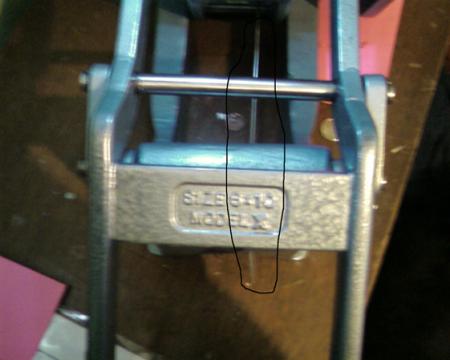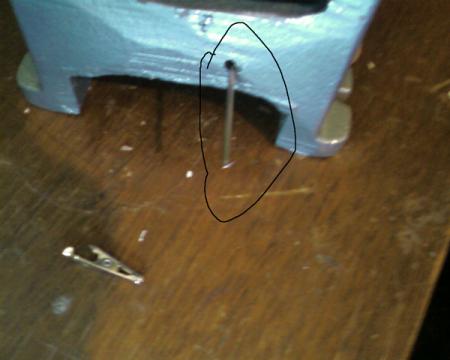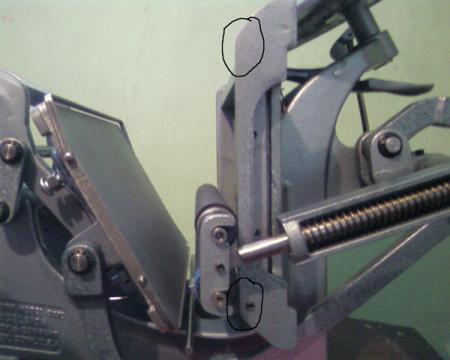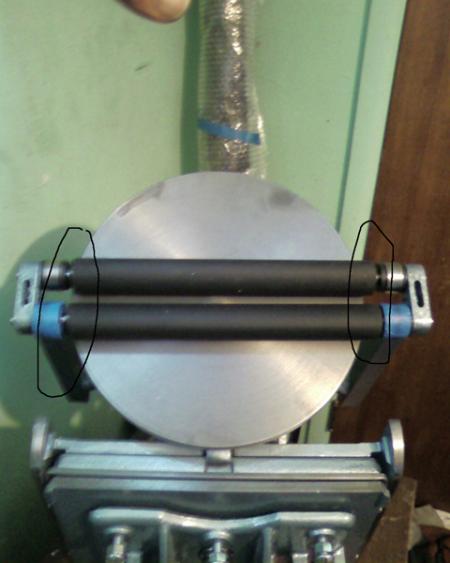whats this do? and this? and this?
Hello, this is my first post and I need some help and guidence. I just bought a letterpress. Kelsey 6 x 10. I dont know what some parts do. When I push the handle, its not a very smooth motion. I have to force it over the top and the bottom parts. I read that I could build my roller trucks up with tape to see if that helps. I only did it with one of the rollers to see with blue tape as you can see in the photos. I dont think it helped. I think I need some adjusting but not sure where to begin. I think it may have something to do with the 5th picture. My rollers also lift off and doesnt look like I would get my type to ink properly. adjusting picture five would seem to help but I think that would make the other problem of rollers getting stuck, picture 4, worse. Any help would be appreciated!

whats this rod do?

closeup of rod

whats this do?

These places are where my rollers get stuck

do I adjust this?

does it matter that my rollers are off center?
Photo three shows the bails that hold the tympan paper on.
I don’t have a Kesley but I found a great site while trying to find out how to clean my Golding Official #4.
Sarah names all the parts at the link below.
http://chrysanthemumpress.blogspot.com/search/label/restoration
The link below goes to boxcar press. They have a manual for Kelsey presses.
“select make=kelsey”
“Select model=All”
“Select PDF=printer’s guide”
http://www.boxcarpress.com/community/flywheel.html?page=/community/flywh...
Hope this helps you.
Grace
Thanks but I already have that manual and it doesnt have the information I am looking for. In order to get the rollers all the way up and down, I have to build up momentum to get it over the top and bottom curves of the chase bed. That doesnt seem right to me.
So I found out photos one and two relate to the gripper bar which is for the gripper arms. but i guess I just dont understand why it needs to stick out of the bottom like that for like in photo two.
Sorry I can’t be of more help. I do have the same problem. The guys at the Letpress Listserv said I have the wrong springs. Now I have to either custom order some springs or play with different compression springs.
You may want to post a question to them as well or look through their archives. They may have had the same problem & posted an answer. They are a great resource; I am a beginner and they have been answering all my printing questions along with briarpress.org.
https://listserv.unb.ca/archives/letpress.html
Grace
I believe picture 2. If it is a little rod. May be from a counter. that is no longer with the press. In any case it is not the bar that your grippers (If you had them) would go onto. If your chase is not in properly the rollers will stick.
Good luck!
Nice photos
Someone has done a very nice job in cleaning that press. It looks brand new.
I do not have a Kelsey. I print with a larger C & P with a flywheel. Your 6 x 10 is a pretty large hand operated press. The top and bottom of the rails are where the springs are at their maximum extension and you are working against that maximum tension. It is normal for the pull to be harder at these points. The larger press with the flywheel evens things out and pulls the rollers through these harder parts. The question remains whether the spring tension is too great on your press or not. That probably can only be judged by a person experienced with the Kelsey operating your press.
You are trying to get going and get printing. That is natural. You have the toy and want to play with it. Please find a way to understand the process rather than guess at remedies. You may need to tape something, but taping the trucks isn’t the way to go.
I can’t tell from the pictures if your press is bolted down. If not, you will need to attach it firmly to a table or bench. You may need two hands to pull the handle.
I will look to see if I can find your email address and communicate directly with you as this is getting a bit long.
inky
When your right your right. I bought it in this condition which was restored. I’ve never used a tabletop before, only a proof press. So, I understand the type, chase aspect of letterpress. Ive also searched under youtube and found a video of a person working a Kelsey tabletop and the movement is much smoother, less effort than mine. My press appears to be a larger version though so that may be the reason. thanks for helping.
I can’t speak directly about Kelseys but a few general comments may help:
1. I would definately bolt the press to the top of a sturdy table. A larger hand-operated press will definately require more leverage than a small one and you don’t want to have to limit your ability to apply it by worrying about it moving.
2. In the close-up photo of the roller hook and spring it shows a series of at least three holes, one of which has a stop-pin through it. It seems to me that the spring tension can therefore be adjusted by releasing tension on the spring and moving the pin to one of the other holes and then releasing the tension. If inserted in a hole closer to the hook end the tension would be increased; if the other way, decreased. It’s hard for me to believe that new springs would be needed.
3. While I’ve seen tape wrapped around the trucks themselves in some special cases the more usual method is to put it on top of the rails the trucks role on. You may not need tape at all and only a trial impression or roller gauge will tell. But if you do need to adjust the height of the rollers I would try taping the rails first.
4. I don’t know a lot about Kelsey presses in particular but looking at the last photo the trucks seem odd to me: they seem rather wide and to have a metal center with rubber or something on either side of that center. They seem wide enough that the inside of the truck would be pressing against the stop-nubs on the core (that engage so the roller and truck turn together) and that the outsides of the trucks are pressing on the roller saddles. If this is in fact happening it would certainly cause the press to be very hard to operate, among other things. The fact they may have come with the press does not mean they are correct or ever worked correctly.
I would take care of and correct as necessary numbers 1, 3 and 4 above before I adjusted the spring tension.
Rich
1. Close the platen bails. They are preventing full movement.
2. That little ‘rod’ is the gripper bar actuating spring. Sliding through the hole applies fulcrum tension.The press is missing the grippers arms, but you can easily observe the rod’s action regardless.
3. Oil the roller assembly - and the rest of the press as well.
4. The Kelsey is an unbalanced press hence the extra effort to move the action easily throughout its range. The roller assembly moves through an arc; obviously, if the arc has high points the action will be slowed thus requiring greater effort by the operator.
5. Don’t put tape on any part of the press; that doing simply masks problems and leads to further misery.
6. Measure the diameter of roller and truck. Rollers should be one point larger than truck. One point.
7. Don’t adjust saddle spring tension unless you are prepared for sloppy inking and uneven forme pressures in the future.
8. READ THE BOOK!
so from what I understand, the rollers and roller trucks should be the same size or 1 point difference. The rollers, as you can see are not even close. Hence me trying to fix the problem with the tape. This picture should show the difference. Its the trucks with a metal washer ring on each side. does this mean I need different rollers?
notice the difference between the truck and roller size
In theory, roller and truck should have identical diameter. In practice, especially on most smaller platens not having dependable ink assembly adjustment - and no, Morgans are not the answer - many variables (uneven rails; worn bed, crushed type) make such achievement impractible - hence roller being one point larger than truck; that is an acceptable compromise.
Replacing the trucks is far less expensive than replacing the rollers. Just take a roller to the machine shop and explain your requirement. Any competent shop will fill your need.
The heart of a press is the inking system. Slap-dash approaches with tape et al is a waste of effort leading only to frustrations. Although not the finest handpress, a Kelsey will produce good product. But only if used as intended. A Mickey Mouse approach produces Mickey Mouse result.
I don’t know enough about Kelsey presses or your particular rollers to say whether the roller diameter is too large or the truck diameter is too small.
I still think the trucks are too wide and are likely pushing or at least coming continously in contact with the roller arms thereby making operation difficult and possibly causing other problems you’re experiencing cycling the press. You should be able to determine this vissually as you try cycling the press.
With the exception of Morgan Expansion Trucks, quite different from these, I’ve only seen steel or some kind of composite trucks such as delrin. But that doesn’t mean others don’t exist. These just seem very strange to me. You may want to check with a roller manufacturer/supplier to verify the correct diameter rollers needed for your model press and replace them, the trucks, or both as necessary. A call to Fritz Klinke at NA Graphics might prove helpful.
Rich
So I went and did a test print and this is one of the results. I printed ‘as’, checked the pressure, printed again and again to get the inking even. You can see at the bottom of the picture the impression or bite from the other side from other test. So it appears to be working. Its just hard to move the rollers up and down. I use my free hand to help push the rollers past the top and bottom rails.
test print
You’ve been given a lot of good advice, to which I can only add: DO bolt your press down,as recommended, if you haven’t already. To a long sturdy (3/4”) piece of plywood if nothing else. You don’t want the press moving around or trying to tip while you’re trying to print! After it’s bolted down and oiled up, check and see if the movement is nice, smooth, and easy with no ink rollers - you want to find out if it’s the rollers or if there are other issues. While Kelseys can do nice printing, they do have a bit of a reputation for their movement not to be as smooth and easy as many other presses. The 6x10” is a pretty big press for a short front handle - compare to the leverage of the long arm on a C&P Pilot. 3x5” Kelseys really aren’t very smooth in operation, at least mine isn’t, and your 6x10” isn’t twice as big, it’s four times the print area - so maybe it takes four times the effort? Your photo 4 seems to show a bit of a “corner” on the roller tracks; my older 6x10” is more rounded there. Once you get your roller and truck size worked out so it’s printing well, I would suspect you may be able to grind or file the “corner” high spot into a slightly more gentle curve that would help the sticking issue, just don’t remove rail height in the chase area, only at the ends.
Well, if you want to see your rollers smash the edge of the inking disk by all means file the rails. If, however, you’d like to give better balance to the Kelsey either extend the handle leverage or counterweight the roller carriage. But for heaven’s sake - don’t take a file to the wee beastie! What next? Sandpaper the platen to remove rust then wonder why you get uneven image pressure? Oh, wait a minute…..
thanks for all the help. My rollers dont actually slide up the rails, they stick out and when I am near the ink plate they return before the corner area. I think this may be an oil issue. What type of oil should I use? Would Wd-40 work? I am learning so much from everyone I feel guilty.
WD40 is a short-term lubricant. When its carrier evaporates the ‘oil’ transforms to a thick gum that provides little lubrication. Use any common automobile oil. The cheappy oil obtained from the supermarket is satisfactory for a hand press. One drop per indicated surface is sufficient (ie: anything moving that touches another part). Ensure excess is wiped immediately else you have spatter over the printed pieces.